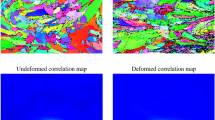Abstract.
For many research areas it is important to know how long one must measure on a given instrument in order to obtain a required level of precision in the measurement of a diffraction peak. This count time is dependent on instrument characteristics, which in turn determine peak signal, shape and background. It is often useful to determine the expected level of precision before the experiment; to plan experiments, to compare instrument capabilities or to check the performance and reliability of peak fitting. We present a method for predicting the precision of peak location, width and intensity in terms of the diffracted signal, peak width and signal to noise ratio. The derivation is for Gaussian peaks, but is broadly applicable to other peak shapes. Our primary interest is the location of peak position for strain measurement, but the methods have a wider range of applicability.
Similar content being viewed by others
Author information
Authors and Affiliations
Additional information
Received: 27 June 2001 / Accepted: 8 January 2002
RID="*"
ID="*"Corresponding author. (Fax: +44-1235/445720, E-mail: mark.daymond@rl.ac.uk)
Rights and permissions
About this article
Cite this article
Daymond, M., Withers, P. & Johnson, M. The expected uncertainty of diffraction-peak location . Appl Phys A 74 (Suppl 1), s112–s114 (2002). https://doi.org/10.1007/s003390201392
Issue Date:
DOI: https://doi.org/10.1007/s003390201392




